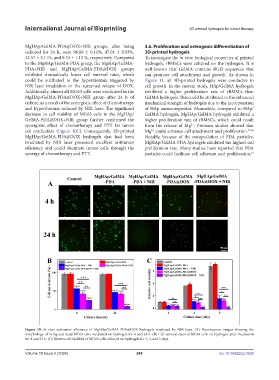Page 257 - IJB-10-5
P. 257
International Journal of Bioprinting 3D printed hydrogels for tumor therapy
MgHAp/GelMA-PDA@DOX+NIR groups, after being 3.6. Proliferation and osteogenic differentiation of
cultured for 24 h, were 96.66 ± 0.11%, 47.01 ± 0.93%, 3D-printed hydrogels
42.57 ± 3.11%, and 8.53 ± 1.12 %, respectively. Compared To investigate the in vitro biological properties of printed
to the MgHAp/GelMA-PDA group, the MgHAp/GelMA- hydrogels, rBMSCs were cultured on the hydrogels. It is
PDA+NIR and MgHAp/GelMA-PDA@DOX groups well-known that GelMA contains RGD sequences that
exhibited dramatically lower cell survival rates, which can promote cell attachment and growth. As shown in
could be attributed to the hyperthermia triggered by Figure 11, all 3D-printed hydrogels were conducive to
NIR laser irradiation or the sustained release of DOX. cell growth. In the current study, HAp/GelMA hydrogels
Additionally, almost all MG63 cells were eradicated in the exhibited a higher proliferation rate of rBMSCs than
MgHAp/GelMA-PDA@DOX+NIR group after 24 h of GelMA hydrogels. This could be attributed to the enhanced
culture, as a result of the synergistic effect of chemotherapy mechanical strength of hydrogels due to the incorporation
and hyperthermia induced by NIR laser. The significant of HAp nanocomposites. Meanwhile, compared to HAp/
decrease in cell viability of MG63 cells in the MgHAp/ GelMA hydrogels, MgHAp/GelMA hydrogels exhibited a
GelMA-PDA@DOX+NIR group further confirmed the higher proliferation rate of rBMSCs, which could result
synergistic effect of chemotherapy and PTT for tumor from the release of Mg . Previous studies showed that
2+
cell eradication (Figure 10C). Consequently, 3D-printed Mg could enhance cell attachment and proliferation. 35,66
2+
MgHAp/GelMA-PDA@DOX hydrogels that had been Notably, because of the encapsulation of PDA particles,
irradiated by NIR laser possessed excellent antitumor MgHAp/GelMA-PDA hydrogels exhibited the highest cell
efficiency and could decimate tumor cells through the proliferation rate. Many studies have reported that PDA
synergy of chemotherapy and PTT. particles could facilitate cell adhesion and proliferation.
67
Figure 10. In vitro antitumor efficiency of MgHAp/GelMA-PDA@DOX hydrogels irradiated by NIR laser. (A) Fluorescence images showing the
morphology of living and dead MG63 cells incubated on hydrogels for 4 and 24 h. (B) Cell survival rates of MG63 cells on hydrogels after incubation
for 4 and 24 h. (C) Relative cell viability of MG63 cells cultured on hydrogels for 1, 3, and 5 days.
Volume 10 Issue 5 (2024) 249 doi: 10.36922/ijb.3526

